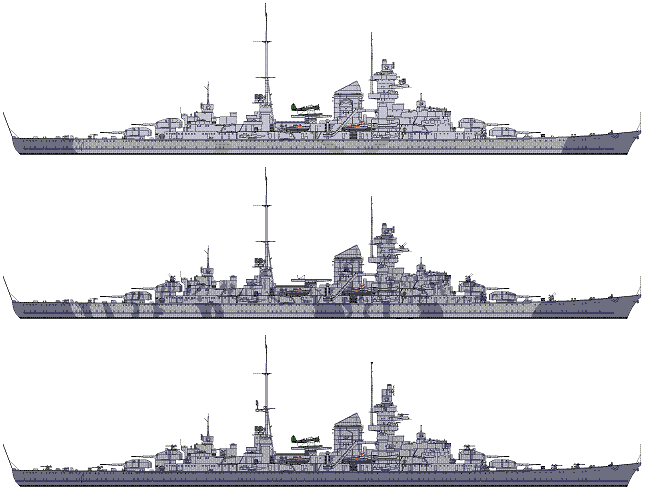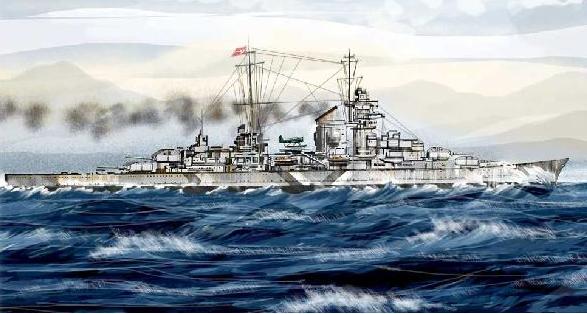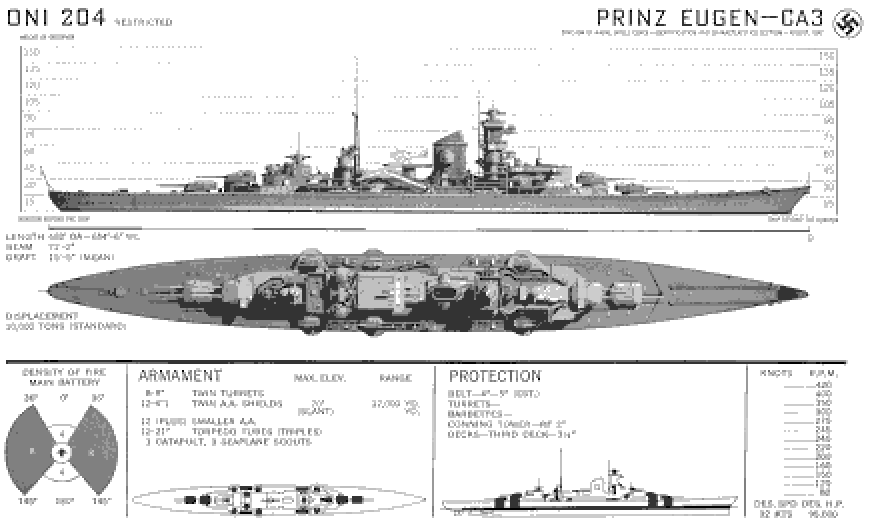The Prinz Eugen was an enlarged Admiral Hipper-class heavy cruiser which served with the Kriegsmarine of Germany during World War II. 
Kreigsmarine Heavy Cruisers - Prinz Eugen Class ==========================================================================

She was named after Prince Eugene of Savoy (Prinz Eugen in German).
After the annexation of Austria in 1938, some former Austrian naval officers were reactivated and served with the Kriegsmarine. The naming of the ship was a tribute to the maritime tradition of the Austro-Hungarian Navy. On 21 November 1942, Prinz Eugen was presented the bell of the Austro-Hungarian dreadnought Tegetthoff (scrapped in Italy in 1924) by the Italian naval attaché assigned to Berlin. The four main gun turrets were named after the Austrian towns of Graz, Braunau, Innsbruck and Wien (Vienna).
Heavy cruisers of the Admiral Hipper Class were products of Germany's race to rearm in the late 1930's and, for their tiime, were some of the world's most formidable and revolutionary warships.
Three ships of the class, Hipper, Blücher and Prinz Eugen, saw service for Germany in World War II. Hipper was damaged in an attack on a convoy on New Year's Eve 1942 and remained out of service until January 1945; she was scuttled at Kiel Deutsche Werke shipyards on 2 May 1945. Blücher was sunk in Oslofjord during the German invasion of Norway. Prinz Eugen survived the war and she sank at Kwajalein Atoll on 22 December 1946 after atomic weapons tests.
A fourth, the Lutzow, was sold to the Soviet Union in 1939 before completion (and the name re-assigned to the Deutschland) where she served the Russians as first the Petropavlovsk and then the Tallinn in the Baltic; she was scrapped in 1950.
A fifth, the Seydlitz, was to be converted into an aircraft carrier; but this project was not completed and she was scuttled at Königsberg in April 1945.

Prinz Eugen was the third ship of the Hipper-class heavy cruisers. Like her sister ships, Admiral Hipper and Blücher, she was built in the mid-1930s. During the planning and design stage, she was known as "Kreuzer J" (Cruiser J). Her keel was laid at the Krupp Germania shipyard in Kiel on 23 April 1936, and her full cost would be 104.5 million Reichsmark. Prinz Eugen was launched on 22 August 1938 and commissioned on 1 August 1940. Considered a "lucky ship", she survived to the end of the war, although she participated in only two major actions at sea. The ship sank following Operation Crossroads at Kwajalein Atoll in 1946.
The Prinz Eugen suffered repeated damage before deployment. On 2 July 1940, the ship suffered minor bomb damage from RAF Bombers. A year later on 23 April 1941, the ship struck a magnetic mine.

On 24 May 1941, Prinz Eugen fought alongside Bismarck in the Battle of the Denmark Strait against HMS Hood, hitting the British battlecruiser three times and starting a huge fire. Doubt had been cast on whether or not Prinz Eugen struck Hood, citing that Hood was not her target. However Prinz Eugen's Gunnery Officer, Paul Schmallenbach, rejects this, confirming Eugen's target was also Hood. Prinz Eugen's war diary, as recorded by Captain Brinkmann, observed:
Both ships initially fire at Hood. The semaphore order from Fleet: "Engage opponent farthest to the left", was not instituted until after the 6th salvo, with a target shift to King George [the Germans mistakenly identified Prince of Wales as King George]. After the impact of 05:57 of the 2nd salvo from Prinz Eugen, a rapidly spreading fire at the level of the aft mast was observed.
Prinz Eugen damaged HMS Prince of Wales also, hitting that battleship four times. The Hood was sunk during the engagement while Prince of Wales was damaged, but managed to hole Bismarck's forward fuel tank, and the German ships were still shadowed by other British warships.
Later that day, owing to fuel loss Bismarck was forced to abandon her commerce raiding mission so Prinz Eugen was detached to continue commerce raiding on her own while Bismarck made for France. Prinz Eugen escaped the British ships, and headed south to rendezvous with the tanker Spichern and prepare for eventual commerce raiding in the Atlantic. After encountering engine problems, the ship made for a French port on 29 May. After narrowly avoiding several British heavy units which were looking for Bismarck, she arrived at Brest, France, on 1 June 1941. The port was regularly bombed by the RAF, and on the night on 1 July, Prinz Eugen was hit on the port side behind the bridge. The bomb detonated in the forward main artillery command centre, killing 60 of the crew.
After the loss of Bismarck, Hitler banned further Atlantic surface raids. Fearing an Allied invasion of Norway, he wanted all capital ships back in home waters. Together with the battlecruisers (or battleships) Scharnhorst and Gneisenau, Prinz Eugen made the "Channel Dash" - Operation Cerberus - back to Germany during 11 February – 12 February 1942.

Prinz Eugen left Germany for Norway in February 1942. On 23 February, she was torpedoed by the British submarine HMS Trident, destroying her stern. After some preliminary patch-up repairs in Trondheim, the cruiser returned to Kiel on 16 May 1942 to receive a new stern. Prinz Eugen was not operational again until January 1943. Two attempts to relocate to Norway, where she could threaten Allied convoys, failed and she was assigned instead to training duties in home waters.
From August 1944 onward, Prinz Eugen was deployed to shell advancing Soviet troop concentrations along the Baltic coast and to transport German refugees to the west. On 15 October 1944, she collided with the light cruiser Leipzig in heavy fog in the Baltic Sea, nearly cutting the smaller ship in two. For 14 hours, the two ships drifted, locked together, until they could be separated. Prinz Eugen was repaired at Gotenhafen (Gdynia) and continued her tasks of shelling Soviet land forces for 26 days of the siege, and evacuating German refugees. On 29 March 1945, she left Gotenhafen for the last time with a load of refugees, reaching Swinemünde on 8 April 1945. The ship then departed for Copenhagen, arriving on 20 April 1945. Lack of fuel meant that she could not leave port again.
At the end of the war, she was one of only two operational German cruisers left (the other was the light cruiser Nürnberg), and was surrendered to British Royal Navy forces in Copenhagen on 8 May 1945. On 26 May the Eugen left Copenhagen with Nürnberg, and sailed to Wilhelmshaven under escort by the British. Prinz Eugen arrived on 28 May, remaining in dry dock until December 1945. On 5 January 1946, the ship was handed over to the United States Navy.
She was awarded to the United States and commissioned into the US Navy as the unclassified miscellaneous vessel USS Prinz Eugen (IX-300). Her very large GHG passive sonar array was removed and installed on the submarine USS Flying Fish for testing. After examination and tests, she was allocated to the target fleet for the Operation Crossroads atomic bomb tests. She survived the Able and Baker tests (July 1946), but was too radioactive to have leaks repaired. In September 1946, she was towed to Kwajalein Atoll and capsized on 22 December 1946 over Enubuj reef, where she remains to this day. In 1978, her port propeller was salvaged and is preserved at the German Naval Memorial at Laboe.
Prior to the atomic tests, the ship's bell was removed by US sailors. The bell currently resides at a new Cold War museum located at the Washington DC Navy Yard..

=================================================================================
NB: The above text has been collected / excerpted / edited / mangled / tangled / re-compiled / etc ... from the following online sources :
KM - Heavy Cruiser Prinz Eugen - wikipedia article #1
KM - Admiral Hipper class Heavy Crusiers - wikipedia article #2



